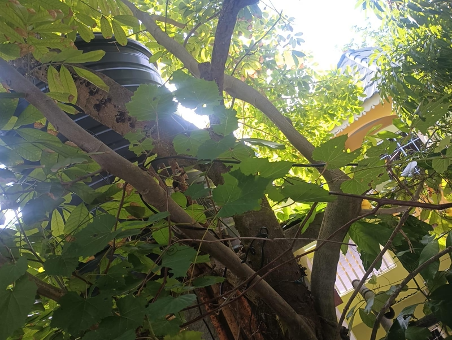CCL, a Rain reader who lives in Clarendon, submitted to us a picture of her grapevine. For more than a year, the plant has been scampering all over fences and trees, with dense foliage but no fruit.
“Is it a man grape?” CCL asked. “Or do I need more patience?”
When we asked our resident agronomist Farmer Linton Neil for some advice, he laughed, “There’s no such thing as a male grape vine in the cultivated grape world. First things first—grapes love lots of sun. The roots can be shaded by using some biodegradables like dry leaf, old newspaper, or dried


grass to retain moisture, and the soil is most ideally loose and well-draining, but the vine itself needs full sun. So hopefully, that vine is in a very sunny area.
“Next, for grapes to fruit, you need to know what to prune, when to prune, and how to prune—this is critical,” he added. “Maybe we’ll just have to use this vine as an experiment because if the variety is unknown and some can take a long time to bear, then the next best thing is to strip all leaves and branches that are not part of the main vine so that the plant can refocus its energy on bearing fruit rather than producing leaves. Plus, it’s best to reduce entanglement with other trees and create some kind of trellis just for the vine. This way, you can better restrain your plant from diseases.”
Mr. Neil shared some pictures with us of his grapevine, which is now fruiting. “Once the flowering starts and the buds emerge, in about five months’ time, the grapes will be ready for eating,” he said.
USES OF GRAPE LEAVES
What can CCL do with all those grape leaves? It turns out that they are actually edible and are widely used in Turkish and Mediterranean cuisine.
Each leaf contains just about three calories, making them low-calorie wrappers for an array of fillings: meats, raw and cooked vegetables, spicy rice, peas and bean stew, etc. Free of cholesterol, fat, and sodium, grape leaves are good sources of vitamins A, B, C, E, and K; and minerals like calcium, iron, potassium, and magnesium. Each leaf has about one-third of a gram of fibre, which can easily reach the recommended 20 to 35 grams per day.
Skin Beauty
According to a 2010 study from the University of Freiburg in Germany, published in the Archives of Pharmacal Research, eating grape leaves can reduce oedema or fluid retention in people with chronic venous insufficiency. The research also showed that grape leaves have impressive antioxidant levels that protect the skin from sunburn and sun-induced skin aging. A study that year from Korea’s Chungbuk National University showed grape leaves may protect the brain from memory loss, possibly aiding in Alzheimer’s prevention.
[Grape stems have also attracted the attention of the cosmetics industry as they are abundant in phenolic compounds. Known for their antioxidant and anti-inflammatory properties, these compounds help to provide great potential for skin health, fight signs of ageing, and help shield against environmental stressors.]
Inflammation Reduction, Liver Protection
A 2012 study from Okayama University’s Graduate School of Medicine, Dentistry, and Pharmaceutical Sciences in Japan examined the potential therapeutic effects of grape leaves’ water extract, and found it may help reduce inflammation and protect the liver. The study also showed grape leaves’ ability to reduce associated inflammation in the body.
Tips on Grape Leaf Harvesting
Experts recommend that morning is the best time for picking grape leaves to eat. Make sure the vine has not been sprayed. Choose medium-sized, shiny, and smooth leaves big enough to use as wraps, and avoid those with tears or holes. You might want to make a V-cut and snip out the stem, which can be toug
h.
Place washed leaves in between moist paper towels in a bag or plastic container. You can use them immediately or freeze them for up to six months.
Preparing Grape Leaves
Blanch leaves in boiling water for a couple of minutes, or brine them. The brine recipe is four parts water to one part salt. Now you are ready to make dishes like dolmas (stuffed grape leaves popular in the Mediterranean), grape leaf pesto, rice and lentil pilaf with chopped grape leaves, salmon grilled in grape leaves, stuffed leaves with cheese and olives, spinach, and grape leaf pie. [The leaves can also be added to your smoothies, chopped and lightly steamed, or added to salads.]
Grape Vines as Water Source
Grape stems contain potable water (safe for drinking). To access, make a cut at any point of the vine (you can start at the bottom) and place a container beneath to catch the water. Then, slice the vine on a slant, several feet up the vine. As the water flow slows, you can make cuts farther down the vine as necessary to extract water.
You can find videos on YouTube showing how to do this.
Additional info from Sourced from livestrong.com and gardeningknowhow.com

